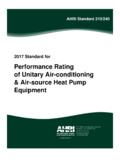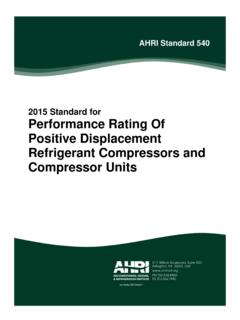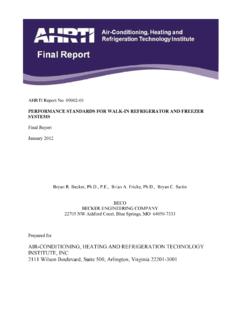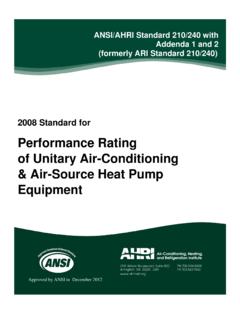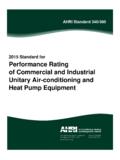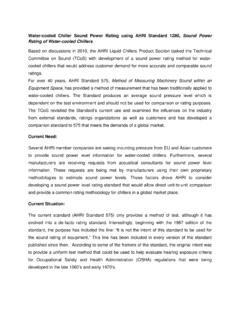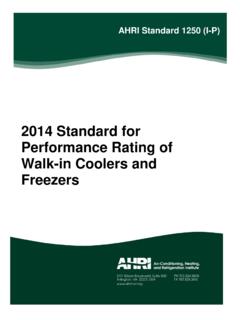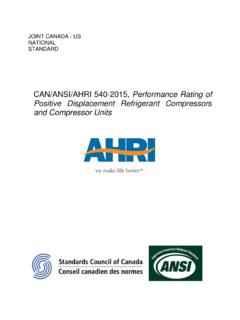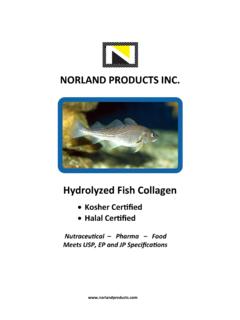Transcription of Compatibility of lubricant additives with HFC …
1 DOE/CE/23810-76 Compatibility OF lubricant ADDITIVESWITH HFC REFRIGERANTS AND SYNTHETIC LUBRICANTSFINAL REPORTPART 1 Richard C. Cavestri, InvestigatorJuly, 1997 Imagination Resources, Blazer Memorial ParkwayDublin, Ohio 43017(614) 793 1972 Prepared forThe Air Conditioning and Refrigeration Technology InstituteUnderARTI MCLR Project Number 660-52600: lubricant ADDITIVESThis project is supported, in whole or in part, by US. Department of Energy grant number DE-FG02-91CE23810: MaterialsCompatibility and lubricants Research (MCLR) on CFC-Refrigerant Substitutes. Federal funding supporting this project of allowable costs. Funding from non-government sources supporting this project consists of direct cost sharing of ofallowable costs; and in-kind contributions from the air-conditioning and refrigeration U. S. Department of Energy and the air-conditioning industry's support for theMaterials Compatibility and lubricants Research [MCLR] program does not constitute anendorsement by the U.
2 S. Department of Energy, nor by the Air-Conditioning andRefrigeration Industry, of the views expressed study was sponsored by the United States Government. Neither the UnitedStates Government, nor the Department of Energy, nor the Air-Conditioning andRefrigeration Technology Institute, nor any of their employees, nor any of theircontractors nor subcontractors make any warranty, expressed or implied, or assumes anylegal liability or responsibility for the accuracy, completeness or usefulness of anyinformation, apparatus, product or process disclosed or represents that its use would notinfringe privately-owned NOTICE[for journal publication submission]By acceptance of this article, the publisher and/or recipient acknowledge the rightsof the U. S. Government and the Air-Conditioning and Refrigeration TechnologyInstitutes, Inc.
3 [ARTI] to retain a non-exclusive, royalty-free license in and to anycopyrights covering this one of this research provides manufacturers of components of air-conditioning and refrigeration equipment with a useful list of lubricant additives , sources,functional properties, and chemical species. The list in part one is comprised of domesticlubricant additive suppliers and the results of a literature search that was specificallytargeted for additives reported to be useful in polyolester of Appendices .. Additive additives ..12 Antifriction Stabilizers ..14 lubricant with Agreement ..16 Principal Investigator Format .. OF APPENDICESA ppendix A lubricant Additive Manufacturers ..19 Appendix B Antioxidant additives ..32 Appendix C Antiwear D Antifriction additives ..53 Appendix E Antiseize F Corrosion G Multifunctional additives .
4 63 Appendix H lubricant Stabilizers ..66 Appendix I lubricant report presents information gathered from an extensive literature survey ofpublished information and contacting lubricant additive manufacturers to identify existingpublished data on the analytical chemistry, degradation, and/or interaction of additiveswith polyolester [POE] lubricants . Included is information on the mode of action ofadditives on metals in the presence of service lubrication of compressors with POEs that do not containadditives is the optimal goal for hermetic compressor use. Chlorine derived from CFCand HCFC refrigerants is reported to have effective antiwear properties and negates thewidespread use of additives in mineral oil lubricated systems. The use of antioxidants formineral oil and POEs has been reported and seems essential.
5 High silicon aluminum tosteel wear seems to be a primary target for additive use while antiwear and antiseizeadditives seem to be a short term go al for use with HFC/POE mixtures. The interactionof specific heteroatom (non-carbon, non-hydrogen) organic compounds with highly polarsurface active synthetic POEs is complex. Information from an extensive literaturesearch describes results from a service base, determined at ambient conditions. Knownlubricant additives used in the hermetic compressor industry, the mode of action ofseveral types of additives and some lubricant additive chemistry that demonstratesselective thermal stability in conjunction with the ch emical structure were objective of the literature search was to investigate commercially availableadditives and review published information on the class of chemical compounds used asadditives with POEs.
6 The search identified chemical compounds that could be added to apentaerythritol [PE] and trimethyolpropane [TMP] POE base stock lubricant in order toalter and improve its antioxidant [AO], antiwear [AW], antiseize [AS], antifriction [AF],corrosion inhibitor [CI], multifunctional additive [MFA], stability additive [SA] andlubricant composition properties. Although every effort has been made to find chemicalcompounds that are reported as useful additives , there are undoubtedly someunintentional reviews discuss the need for POEs (1, 2, 3), their benefits (4) and howcarboxylic acid and alcohol selection affects thermal stability and viscosity (2, 5). Earlywork focused on development of ester lubricants (1) that would outperform mineral HVAC industry has settled on the PE and TMP base stocks; however, the chemistryand types of POEs in refrigeration compressors is relatively new and nearly all chemicaland additive formulations of current refrigeration grade POE lubricants are paucity of this information made performance correlations of currently usedrefrigeration grade POEs with that of new and old published information nearlyimpossible.
7 However, the ASHRAE and the MCLR research programs have providedfunding to develop fluid property data on most of the currently used POEs (6, 7).8 The choice of POEs selected by HVAC engineers was first based on historicalCFC and HCFC mineral oil miscibility characteristics. Perhaps assumptions were madeon the lubricity of the esters in the hermetic system based on viscosity and how wellesters lubricated gears and rolling el ement bearings in jet aircraft (1). Within the lastthree years, proactive lubricant suppliers developed POEs suitable for durable compressorservice. Currently available POEs differ chemically in one way or another; however,there is still a need to better understand the sensitivity of various compressor designs anden gineering ch aracteristics to obtain optimum and carboxylic acids are the primary modifiers of HFC miscibility,thermal stability, and fluid properties.
8 Alkyl branching of carboxylic acids promotesHFC miscibility whereas linear acids promote immiscibility. A wide variety ofstructurally different esters was studied. The results obtained from a stick-slip machineclearly identified esters made of linear acids. These linear acids are better than mixed andbranched esters for lubricity. Lubricity also varies with the structure of the alcohol (8).Hermetic compressor engineers require miscibility for good lubricant return requirements of a POE have dictated reduced lubricity due to branched acidrequirements. By properly tailoring the carboxylic acid composition of POEs, aneffective balance of liquid/liquid miscibility and lubricity can be ent evidence exists that suggests less or partially miscible POEs can returnto the compressor. Refrigerant gas equilibrium solubility studies, with single and blendedrefrigerants, almost equally reduce the viscosity of fully and partially miscible POEs atidentical conditions (6).
9 This information should help in selecting POEs that would havebetter lubricity at the start, namely a more linear product. We cannot expect esters andmineral oils to behave identically. They are two different classes of chemicals withdifferent physical and chemical properties. Many studies and reviews show mineral oilwith low viscosity indices to have superior shear viscosities, EHD, and density qualities(9, 10, 11).The characteristics of a good compressor lubricant are to seal gas spaces, providea tough hydrodynamic film, provide a dense lubricant sealing wedge on the leading edgesof piston rings, and provide good impact films. Chlorine bearing refrigerants promote amono layer of ferric chloride on metal surfaces. Ferric chloride on metal surfaces isknown to provide a lubricious layer resulting in the lubrication performance of mineraloils with CFC and HCFC refrigerants (12).
10 9 Unlike naturally occurring hydrocarbon fluids, POEs are synthetic materials thatcan be widely varied by altering the ratio of linear and branched carboxylic POEs can have totally different performance properties amongst suppliers ofidentical viscosity grades [VG], whereas supplies of refrigeration grade hydrocarbonshave a narrower most common 32 ISO VG mineral oil used in the refrigeration industry forthe last 35 years is a blend of two straight distillation cuts of hydrocarbons. When earlylubricants were combined with CFC refrigerants, severe copper plating and thermalinstability of hermetic system lubrication were the predominate failure , a very light acid treatment followed by clay filtration of the same lubricantsimproved thermal stability of the chlorinated refrigerant lubricant mixture andcompressor performance.
